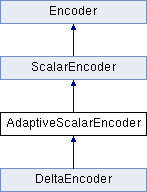 |
NuPIC
0.2.7.dev0
Numenta Platform for Intelligent Computing
|
 |
NuPIC
0.2.7.dev0
Numenta Platform for Intelligent Computing
|
This is an implementation of the scalar encoder that adapts the min and max of the scalar encoder dynamically. More...

Public Member Functions | |
| def | __init__ |
| [overrides nupic.encoders.scalar.ScalarEncoder.__init__] | |
| def | setFieldStats |
| TODO: document. | |
| def | getBucketIndices |
| [overrides nupic.encoders.scalar.ScalarEncoder.getBucketIndices] | |
| def | encodeIntoArray |
| [overrides nupic.encoders.scalar.ScalarEncoder.encodeIntoArray] | |
| def | getBucketInfo |
| [overrides nupic.encoders.scalar.ScalarEncoder.getBucketInfo] | |
| def | topDownCompute |
| [overrides nupic.encoders.scalar.ScalarEncoder.topDownCompute] | |
| def | dump |
| Prints details about current state to stdout. | |
 Public Member Functions inherited from ScalarEncoder Public Member Functions inherited from ScalarEncoder | |
| def | __init__ |
| w – number of bits to set in output minval – minimum input value maxval – maximum input value (input is strictly less if periodic == True) More... | |
| def | getDecoderOutputFieldTypes |
| [Encoder class virtual method override] | |
| def | getBucketIndices |
| See method description in base.py. | |
| def | encodeIntoArray |
| See method description in base.py. | |
| def | decode |
| See the function description in base.py. | |
| def | getBucketValues |
| See the function description in base.py. | |
| def | getBucketInfo |
| See the function description in base.py. | |
| def | topDownCompute |
| See the function description in base.py. | |
| def | closenessScores |
| See the function description in base.py. | |
 Public Member Functions inherited from Encoder Public Member Functions inherited from Encoder | |
| def | getWidth |
| Should return the output width, in bits. More... | |
| def | encodeIntoArray |
| Encodes inputData and puts the encoded value into the numpy output array, which is a 1-D array of length returned by getWidth(). More... | |
| def | setLearning |
| Set whether learning is enabled. More... | |
| def | setFieldStats |
| This method is called by the model to set the statistics like min and max for the underlying encoders if this information is available. More... | |
| def | encode |
| Convenience wrapper for encodeIntoArray. More... | |
| def | getScalarNames |
| Return the field names for each of the scalar values returned by getScalars. More... | |
| def | getDecoderOutputFieldTypes |
| Returns a sequence of field types corresponding to the elements in the decoded output field array. More... | |
| def | setStateLock |
| Setting this to true freezes the state of the encoder This is separate from the learning state which affects changing parameters. More... | |
| def | getEncoderList |
| def | getScalars |
| Returns a numpy array containing the sub-field scalar value(s) for each sub-field of the inputData. More... | |
| def | getEncodedValues |
| Returns the input in the same format as is returned by topDownCompute(). More... | |
| def | getBucketIndices |
| Returns an array containing the sub-field bucket indices for each sub-field of the inputData. More... | |
| def | scalarsToStr |
| Return a pretty print string representing the return values from getScalars and getScalarNames(). More... | |
| def | getDescription |
| This returns a list of tuples, each containing (name, offset). More... | |
| def | getFieldDescription |
| Return the offset and length of a given field within the encoded output. More... | |
| def | encodedBitDescription |
| Return a description of the given bit in the encoded output. More... | |
| def | pprintHeader |
| Pretty-print a header that labels the sub-fields of the encoded output. More... | |
| def | pprint |
| Pretty-print the encoded output using ascii art. More... | |
| def | decode |
| Takes an encoded output and does its best to work backwards and generate the input that would have generated it. More... | |
| def | decodedToStr |
| Return a pretty print string representing the return value from decode(). | |
| def | getBucketValues |
| Returns a list of items, one for each bucket defined by this encoder. More... | |
| def | getBucketInfo |
| Returns a list of EncoderResult namedtuples describing the inputs for each sub-field that correspond to the bucket indices passed in 'buckets'. More... | |
| def | topDownCompute |
| Returns a list of EncoderResult namedtuples describing the top-down best guess inputs for each sub-field given the encoded output. More... | |
| def | closenessScores |
| Compute closeness scores between the expected scalar value(s) and actual scalar value(s). More... | |
| def | getDisplayWidth |
| Calculate width of display for bits plus blanks between fields. More... | |
| def | formatBits |
| Copy one array to another, inserting blanks between fields (for display) If leftpad is one, then there is a dummy value at element 0 of the arrays, and we should start our counting from 1 rather than 0. More... | |
This is an implementation of the scalar encoder that adapts the min and max of the scalar encoder dynamically.
This is essential to the streaming model of the online prediction framework.
Initialization of an adapive encoder using resolution or radius is not supported; it must be intitialized with n. This n is kept constant while the min and max of the encoder changes.
The adaptive encoder must be have periodic set to false.
The adaptive encoder may be initialized with a minval and maxval or with None for each of these. In the latter case, the min and max are set as the 1st and 99th percentile over a window of the past 100 records.
Note: the sliding window may record duplicates of the values in the dataset, and therefore does not reflect the statistical distribution of the input data and may not be used to calculate the median, mean etc.
 1.8.3.1
1.8.3.1